Petra Iris
Iris aff. petrana




Iris petrana is a geophyte in the Iris section Oncocyclus that is 35-50 cm tall. It grows in clumps with several shoots; each shoot has several individual leaves, which are flat, sword-shaped and arched. From their center (in good conditions), a flower stalk usually develops, bearing a single dark purple to blackish flower, with a diameter of 6-7 cm, which is wider than its height. I. petrana blooms in March.
The species distribution is limited to the northern Negev from the Rotem
Plain to the Seckher sands. The large populations grow in the Yeroham Valley
between Yeroham and Dimona. Additional populations grow on the Yamin Plain, at Rotem
Junction and in Wadi Aro’er. The historic and recent distributions are probably
identical. There is no information about populations in the area of the nuclear
reactor.
Grows in sandy loess plains and stabilized sand fields over Neogene
sandstone at altitudes of 340-570 m.
This is one of the two
southernmost species of the royal irises – (the second species is Iris mariae). It is adapted to desert
conditions: its leaves are small, narrow and much curved; its flowers are also
the smallest among the Iris species in Israel (except for Iris mariae).
Avishai proposed the population from Yeroham be considered a separate
species (I. hieruchamensis), in the 1970s but this opinion was not
formally published. Feinbrun subsequently united the Negev population with Iris
petrana from the Edom Mountains into one species – Iris petrana.
Thus, the combination of the Latin name “Petra” and the Hebrew name “Yeroham.” The
taxon was never reevaluated since then. Despite the morphological similarity
between the Edom populations and the northern Negev populations, there are
apparently significant differences between the two, and they grow in extremely different
environmental conditions. The Petra population gradually shifts to Iris
nigricans, while the Yeroham population shifts to Iris atrofusca in the
eastern Be’er-Sheva valley. The Negev I. petrana may have
speciated from Iris atrofusca, while the Edom I. petrana
speciated from Iris nigricans, common in Moab. In our opinion, both the Yeroham
and Edom populations should be considered separate taxa and be given high
values for preservation in terms of their degree of endemism and connectivity.
The population at the Yeroham
Iris Reserve includes particularly high concentration of individuals lacking pigmentation
in their flowers and colored pink, golden and whitish. The intensity of this
phenomenon could be a sign of a particularly high genetic diversity in this
population.
·
Iris petrana grows in the sandy loess valleys and in sand derived from sandstone erosion
from the Yeroham Valley and the Rotem Plain. These are flat areas suited for
earthworks and development. Consequently, the military and industry are
destroying these habitats, which are extremely threatened. Only the habitat
within the area of the Negev Nuclear Research Center remains protected, but
there is no information about the size of the populations there.
·
Its distribution pattern is
patchy; the population is composed of several densely populated patches separated
by hundreds and thousands of meters.
·
Over the past 50 years,
there has been a drastic reduction in the sizes and number of populations.
·
Assuming that the
populations in the Negev are identical to those in Edom, their presence in a
neighboring country does not reduce their degree of endangerment. In Jordan,
the black irises are formally protected, but in reality, many of their rhizomes
are uprooted.
·
Protected at the Iris
petrana Reserve between Yeroham
and Dimona
Controlled grazing
encourages growth, but destructive grazing in which leaves and flower buds are
consumed should be prevented.
Endemic to the northern Negev in
Israel and to southern Jordan.
According to the current
classification, this is an endemic species to Israel and Jordan, although it is
probably endemic to Israel alone, which is separated geographically,
morphologically and apparently genetically as well from the populations in
Edom. It is the southernmost geographic location of the Oncocyclus section (parallel to Iris mariae in the western Negev). Its preservation
is particularly important due to its endemic status, rarity, attractiveness,
and the fact that it is one of the two desert species of the Oncocyclus section
at the southernmost boundary of its distribution.
Al-Eisawi,D.M.H., 1998 Field Guide to Wild Flowers of Jordan and neighbouring countries. Amman, Jordan:
Commercial Press, Jordan Press Foundation "Al Rai". 296 pp.
Current Occupancy Map
| 1000 squre meter pixel | 5000 squre meter pixel | 10000 squre meter pixel | |
|---|---|---|---|
| number of observations | 0 | 0 | 0 |
| in total pixels | 0 | 0 | 0 |
| Family | Iridaceae |
| Classification | On the endangered species list |
| Ecosystem | Desert |
| Chorotype | Sub-Endemic, Western Irano-Turanian |
| Conservation Site | Irus Yeroham Nature Reserve. Among this population there are also items with yellow-golden flowers |
| Rarity |
1
1
6
|
|---|---|
| Vulnerability |
0
0
4
|
| Attractiveness |
0
3
4
|
| Endemism |
0
4
4
|
| Red number |
1
4.7
10
|
| Peripherality | N |
| IUCN category | DD EW EX LC CR EN VU NT |
| Threat Definition according to the red book | Endangered |
 Based on:
Based on:






